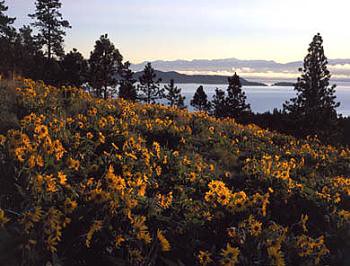Arrow leaf Balsam Root, Chapter Two
Bert Gildart: If I were producing a musical about Montana flowers, it would be appropriate to steal from the classic The Hills Are Alive With the Sound of Music, staring Julie Andrews.

Arrow leaf Balsam Root & Flathead Lake
In part that’s due right now to the Arrowleaf balsam root, still making its gaudy appearance on so many dry slope areas of Montana. In part I use the hills surrounding the Conrad Cemetery in Kalispell as an indicator for spring boat trips to Wildhorse Island, for all of the cemetery’s dry north facing slopes are now running wild with yellow. The hills face the highway as you drive into town.
I mentioned some of the specie’s qualities in my last post, but did not mention its scientific name, which is reflective of its food value. That’s part of the reason for this post—Chapter two if you will.
Another reason is that this photo is an instructive photo, and I thought the information might be useful to some. Of course, we also want to post reminders that some of this material on Wildhorse is covered in our new book. The link will take you to Falcon guides and to access our book, click the Book category, then the exploring catetory. The book can also be purchased by E-mailing us.
Indeed, the scientific name Balsamorhiza sagittata, speaks to the specie’s palatable properties. “Balsamon” means balsam and “rhiza” means root. The sap in the tough woody roots smells and feels like balsam fir pitch. “Sagittata” means arrow-leaved. Other information about the way in which local Native Americans used the species is included in my last posting.
This photo was made just as the sun was appearing, imparting the warm cast to the photograph. I made the photo with a 4×5 camera, and used a wide angle lens. Even with the advances in digital photography—and I am an advocate—it is virtually impossible to beat the old view camera for detail and depth of field.
Patience, however, is required, as you must generally wait for the flutter of leaves to cease so you can stop down your camera’s lens. Technical data for this photo includes a 1 sec exposure at f32—rendering everything tack sharp throughout this landscape’s extensive sweep.
—–
4th ed. Autographed by the Authors
Hiking Shenandoah National Park
 Hiking Shenandoah National Park is the 4th edition of a favorite guide book, created by Bert & Janie, a professional husband-wife journalism team. Lots of updates including more waterfall trails, updated descriptions of confusing trail junctions, and new color photographs. New text describes more of the park’s compelling natural history. Often the descriptions are personal as the Gildarts have hiked virtually every single park trail, sometimes repeatedly.
Hiking Shenandoah National Park is the 4th edition of a favorite guide book, created by Bert & Janie, a professional husband-wife journalism team. Lots of updates including more waterfall trails, updated descriptions of confusing trail junctions, and new color photographs. New text describes more of the park’s compelling natural history. Often the descriptions are personal as the Gildarts have hiked virtually every single park trail, sometimes repeatedly.
Big Sky Country is beautiful
Montana Icons: 50 Classic Symbols of the Treasure State
![]() Montana Icons is a book for lovers of the western vista. Features photographs of fifty famous landmarks from what many call the “Last Best Place.” The book will make you feel homesick for Montana even if you already live here. Bert Gildart’s varied careers in Montana (Bus driver on an Indian reservation, a teacher, backcountry ranger, as well as a newspaper reporter, and photographer) have given him a special view of Montana, which he shares in this book. Share the view; click here.
Montana Icons is a book for lovers of the western vista. Features photographs of fifty famous landmarks from what many call the “Last Best Place.” The book will make you feel homesick for Montana even if you already live here. Bert Gildart’s varied careers in Montana (Bus driver on an Indian reservation, a teacher, backcountry ranger, as well as a newspaper reporter, and photographer) have given him a special view of Montana, which he shares in this book. Share the view; click here.
$16.95 + Autographed Copy
What makes Glacier, Glacier?
Glacier Icons: 50 Classic Views of the Crown of the Continent
![]() Glacier Icons: What makes Glacier Park so special? In this book you can discover the story behind fifty of this park’s most amazing features. With this entertaining collection of photos, anecdotes and little known facts, Bert Gildart will be your backcountry guide. A former Glacier backcountry ranger turned writer/photographer, his hundreds of stories and images have appeared in literally dozens of periodicals including Time/Life, Smithsonian, and Field & Stream. Take a look at Glacier Icons
Glacier Icons: What makes Glacier Park so special? In this book you can discover the story behind fifty of this park’s most amazing features. With this entertaining collection of photos, anecdotes and little known facts, Bert Gildart will be your backcountry guide. A former Glacier backcountry ranger turned writer/photographer, his hundreds of stories and images have appeared in literally dozens of periodicals including Time/Life, Smithsonian, and Field & Stream. Take a look at Glacier Icons
$16.95 + Autographed Copy

